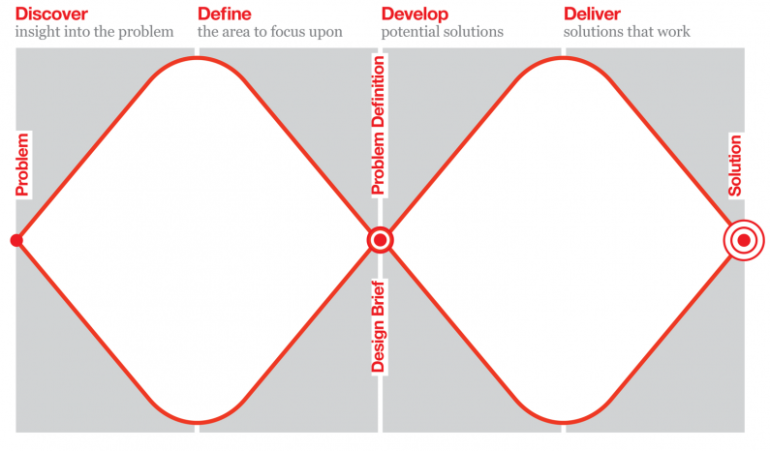The Delight Conference, run by Connective DX in Portland, is billed as a unique two day gathering of designers, technologists and businesses that care about creating experiences people love
Part 2 of 3
Having had a few of weeks to reflect since attending the Delight Conference, what has bubbled to the top - what’s still resonating?
There are three things which are still ringing in my ears:
- We heard from every single speaker about organisational culture in one way or another - more below. (First blogpost)
- Make sure you’re solving the right problem - get this bit right, and you can do some really awesome stuff.
- Yet the images which are still flashing before my eyes are the short clips that Josh Clarke showed of the possibilities for the future when we move away from using a screen as an interface.
This is the second of 3 blogposts inspired by Delight.
The first obstacle people face when they try to innovate is finding the right problem to solve. All too often people jump to solution space before fully exploring the problem. Although this is nothing new, it was mentioned a couple of times on the first day of the conference and is worth highlighting.
According to Suzanne Pellican of Intuit, a cancer for any company is when employees and upper management fall in love with a solution and don’t let it go. We already learnt from Suzanne in my first blogpost last week that people have a problem in selecting bad ideas. That kills innovation every time. So it’s absolutely mission critical to get people to fall in love with the problem and explore it fully before they fall in love with a solution. We see this frequently in our innovation workshops - it’s human nature to jump to solution space before fully exploring the problem and it requires a disciplined mind and / or a disciplined process to stick with the right phase.

We always ask participants to come to our “Innovation Unpacked” workshops with a work based problem. We usually get around a 30% hit rate where people present a well formed problem statement. Others are predetermined solutions, questions, someone else’s fault or conflated issues. If you’re looking to frame a problem statement, it’s a good idea to start with “The problem is that ……” and remain alert to the traps mentioned above. Even using the sentence structure provided, people can’t resist providing a solution within their problem statement, such as “The problem is that we don’t have enough staff”. This implies that the solution is “we need more staff”. A better framed problem might be “The problem is that staff are overworked”. This opens the way to a greater number of potential solutions and the best way to have a good idea is to have lots of them to chose from.
Once you’ve come up with a multitude of ideas to solve your problem, how do you then select the most fruitful one? This is where it’s useful to have a clear vision of where your organisation is going. At Intuit, staff routinely selected the crappy ideas. They generally went for the ones that they themselves could see through to the end. They had to change mindsets and focus on those ideas that provided the greatest delight for customers.

The Design Council’s Double Diamond is a useful tool for helping to think about the different phases of a design process. They are divided into - Discover, Define, Develop, Deliver. The divergent lines of the diamond represent divergent thinking, where a number of possible ideas are created and the convergent lines represent convergent thinking, where the possibilities are refined and narrowed down. This happens twice during the process. Once to firm up on the problem and once to select the right solution. The Design Council point out that “one of the greatest mistakes is to omit the left-hand diamond and end up solving the wrong problem”. The third and fourth phases help with selecting the best solutions (not just the ones you can see through to the end) and the process is iterative, so you develop, test and refine a number of times with poor ideas eliminated in the process.
That’s the theory, but what does this look like in practice?
Golden Krishna of Zappos Labs - the R&D Lab for shoe retailer Zappos, talked at the Delight Conference about a challenge they faced when with 60 days to go before the largest running race in N America, Bay to Breakers with 70,000 participants, they were asked to ‘do something innovative’. So, where do you start with that seemingly daunting task?
By spending time carefully exploring the big problems facing people going to the event, they were able to come up with a solution that truly impacted on the user experience. After exploring a number of problems, they found that people complained of really long queues at the expo space and settled on this as the problem they’d try and solve. The expo is where registered runners go to get their race numbers before visiting the sponsors store. Last year people experienced 40 minute queues. They wanted to create a better customer journey and a radically simple checkout experience. Inspired by a 1993 TV commercial by AT&T, they attached RFID tags https://en.wikipedia.org/wiki/Radio-frequency_identification to every item for sale in the expo. When customers placed their basket of goods on the checkout all the items automatically appeared on the screen and customers simply touched “OK” to proceed to payment. They reduced waiting times from around 40 minutes to 2 minutes. By carefully considering what the biggest problem was facing the event, Zappos Labs were able to design a delightful customer experience.
Look out for part 3 of this blog next Friday where I'll be taking a glimpse into the future.
EDIT: Check out our latest 4 part workshop series "Unlocking Innovation" - that guides staff through problem definition, ideation, designing solutions, evaluation and iteration.
